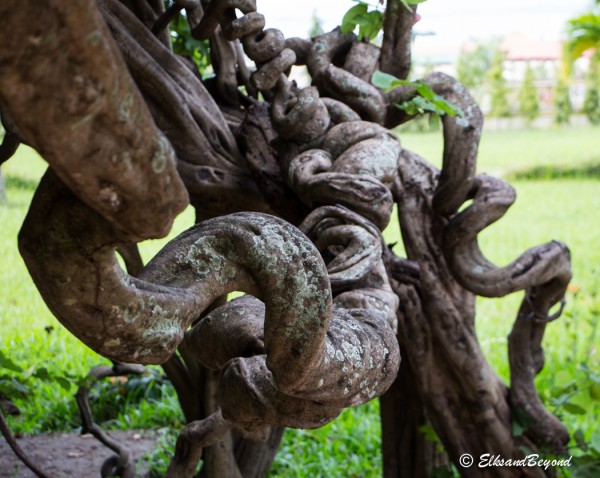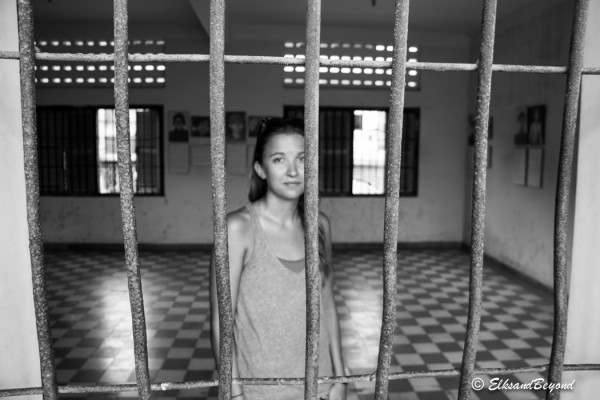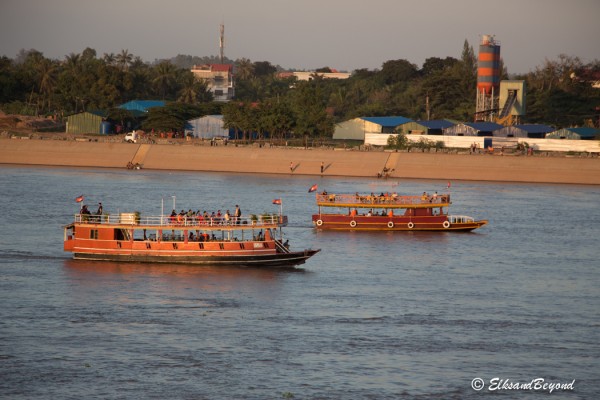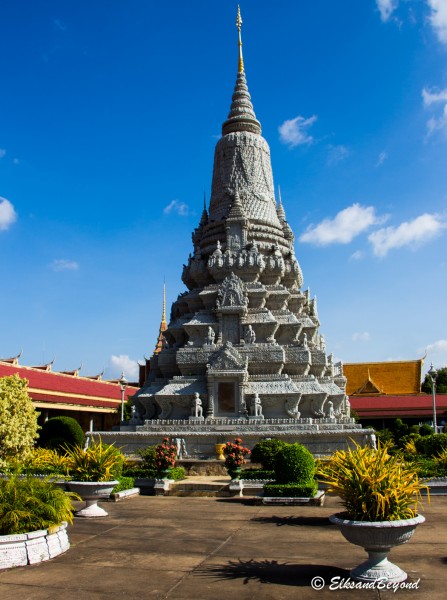I arrive late at night into Phnom Penh, Cambodia I find the cheapest taxi I can, and as we cruise the all but empty streets in the back of a Tuk Tuk it feels good to be setting out on a new adventure. Phnom Penh is a nice enough city, it has everything you need, and by Cambodian standards is fairly modern. But that’s just it, it’s a big city, and as such I arrive late at night, and I am already excited to move on. Hold up. There is some important history to check out here, so Elisabeth and I decide that we had better learn something before skipping town.
Something that most of the world knows very little about is the reign of Pol Pot over Cambodia in the 70’s. He was something akin to that of Hitler, but it was 3rd world Asia, so no one really took notice or care, I certainly didn’t learn about it in my “college prep school, charter school, liberal arts…yada yada yada”. The gist of it is, that Pol Pot killed about 25% of the population in forced labor camps and mass grave executions. If you know nothing about this history, here is a place to start.
The killing fields as they are called in Cambodia, and the history associated with them are a rather stunning and sobering experience to say the least. It’s unbelievable to me, and perhaps even shameful that I knew nothing about this place before opening up a Cambodian guide book. The Khmer Rouge tortured, starved, and killed millions of local men, women, and children from 1975-1979, and held on to some scrap of power until the 1990’s!
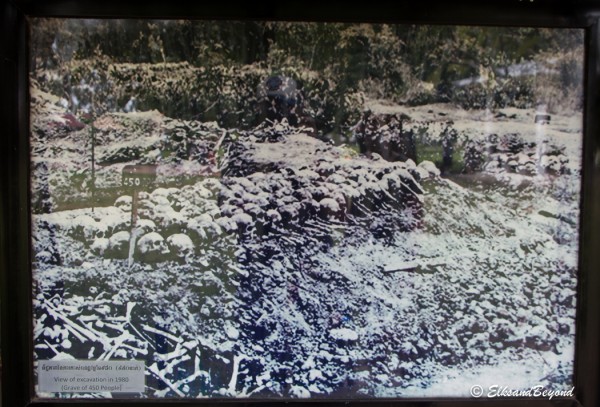
A grave excavated in the 1980’s that was the terrible place that 450 people were buried in one big mass grave.
Back to the killing fields. The current ones outside of Phnom Penh are just one location of many where this sort of genocide took place. As we enter the walking tour the now peaceful green fields with previously excavated graves give way to images of massive graves of bones and clothing remains from mass executions. Another stop along the way brings us to so called “killing tree,” whose sole use was to kill infants and toddlers by beating them against it rather than waste a bullet. Everywhere you walk there is another sight where another massive grave has since been excavated and turned into a memorial. As we arrive at the end of the tour there is a large tower that houses thousands and thousands of the human skulls that have been recovered from the sites. A truly somber experience.
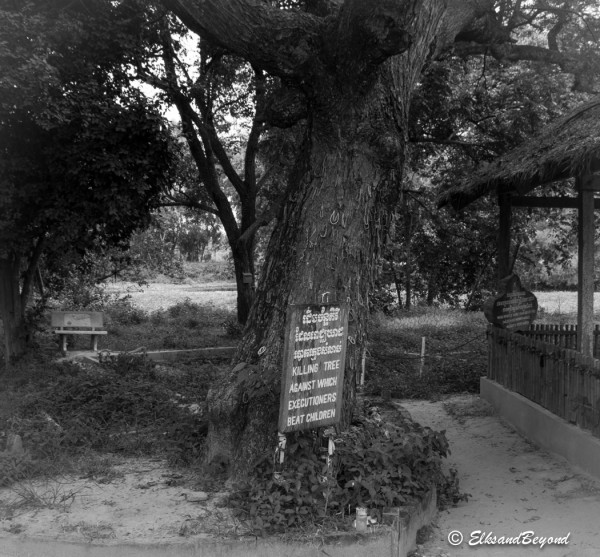
Instead of “wasting” bullets, the executioners would just smash small children and infants against this tree to insure their death.
Experiences of this sort are what makes me wish as an American that I was more informed on what really happens around the world. It’s almost as though, it happened in Asia, so no one cares enough to do anything about it, but when Hitler did the exact same thing in the Western world, it sparked the biggest war in history. On our way back to town in the back of a Tuk Tuk, we arrived at the the war museum. It’s been an eye opening day so far, and this was the icing on the cake.
The pictures here rival those from the concentration camps in Auschwitz that I visited a few years ago. The torture, the harsh conditions, the starvation, and sheer inhumane treatment that is hard for any sane person to contemplate. As we walk through the different rooms of the museum it is an overload of the pictures taken by the Khmer Rouge of Victims as they arrive, and the different forms of torture used, and with survival rare. It is room after room with pictures of people so close to the edge of death that there skin is hardly clinging to bone.
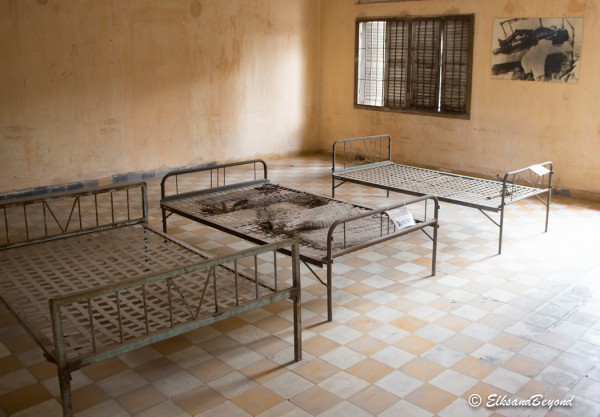
One of the rooms where people would be chained to these cots and tortured in the most unimaginable ways. Notice the photo in the top right corner on the wall.
Leaving the museum, there isn’t a lot of conversation on the way back to town, we are stunned and ashamed of our ignorance. This sort of thing still happens in Africa, how does it go on? How do the western countries choose where to intervene and where to turn a blind eye.
I’ll leave my rant behind for now as we enjoy the evening in Phnom Penh, still getting used to paying less for a full outing for both of us than I can eat for at the Aspen Mcdonalds. If you head to more of a local joint where the prices are likely to still be in riel, and you won’t believe what you can get for about $1-2 a person and it gets better outside the big cities. I should mention that Cambodia unofficially uses the US dollar for almost a all transactions, however they don’t use our coins, so therefore when something cost 2.75 the .25 back in riel at 4000 riel to the dollar, so 1000 riel for your quarter.
We awake in the morning and head out for a walk around town and hit up the silver pagoda and the royal palace. The palace was closed so we opted for the Pagoda. A very ornate structure by Cambodian standards, but once you have seen some of what Thailand has to offer, much of the rest of Southeast Asia fails in comparison with the Thai wealth and eye for art.
Feeling the itch to get a move on we arrange transportation to Siem Reap, near Angkor Wat. Elisabeth is a structural engineer and this is something she was looking forward to nerding out on; me, I’m just along for the ride on this section.
